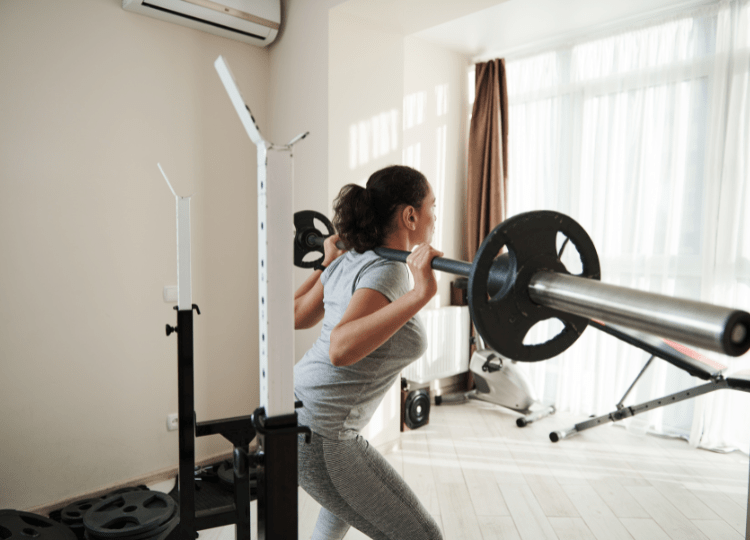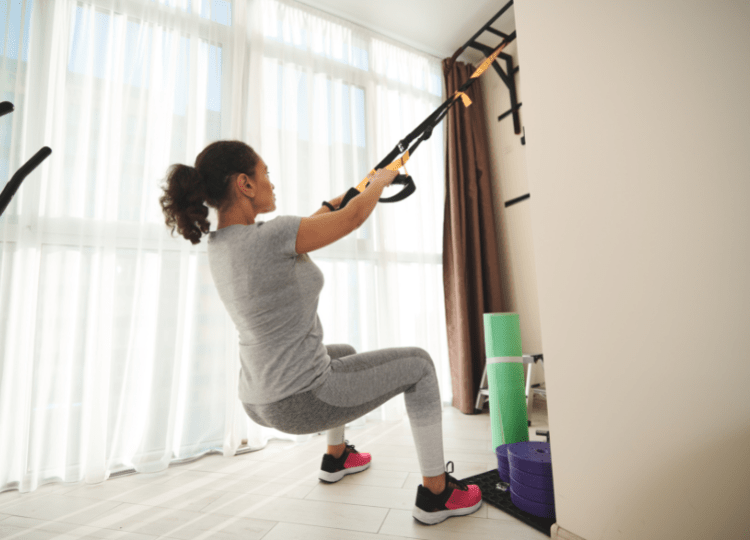Home and garage gyms have become increasingly popular in recent years… but the advice and recommendations often doesn’t cater for those in apartments and studio flats.
It’s one thing buying equipment like a squat rack for a spacious garage… it’s another thing trying to do that for a tiny apartment.
But no need to give up on the idea of lifting weights in your apartment altogether… with some careful planning (and common sense), there’s no reason you can’t create an effective workout space in the smallest of spaces.
In this guide, we outline some tips and recommendations for doing it safely (and how to ensure you don’t annoy your neighbors in the process!)
Things to Consider About Your Apartment
Ceiling Height
One of the first things to consider about lifting weights in an apartment and building your very own apartment gym, is the ceiling height. Some apartments can have pretty low ceilings, which could be an issue in terms of any overhead exercises, along with getting a larger squat rack into the space too.
Measure up your ceilings and when you’re buying something like a squat rack, ensure it will fit once it’s assembled.
Building Age
The building age will also largely impact your weightlifting experience. There will of course be exceptions, but most modern apartments will likely be able to handle more weight.
Older apartments may not have been built to withstand additional weight from something like weightlifting, so it’s something to bear in mind.
Ultimately, you’ll probably have to ask permission or at least get some understanding of the max weight your apartment can hold. This should be something your landlord or facilities manager can get for you.
Thin Walls
If you can hear your neighbors talking, then chances are, they can hear you… which means banging weights on the floor will certainly be something they’re aware of. This means taking extra measures to reduce the noise.
If, however, your apartment is by and large very quiet, the building might be better insulation to drown out noises from each apartment.
Calculate Space Needed
The final step to consider about your apartment is the space available and space needed. Squat racks can look pretty big in the gym… but when you fit them in a tiny apartment, they can look absolutely gigantic! So, you probably need to think very strategically about what equipment you really want and the amount of space it will take up.
For example, if you want to lift weights in your apartment to supplement your gym routine, you may just decide a barbell and some bumper plates are enough… however, if you don’t want to go to the gym at all, you may need some sort of squat rack (if you’re planning on doing squats, of course) and bench.
As well as the floor plan that the equipment will take up, you want enough room around it move freely to add weights and for the experience not to feel really cramped.

Weightlifting Tips for an Apartment
Invest in Floor Pads and Deadlift Platform
Investing in floor pads and a deadlift platform should definitely be on your shopping list.
This will help reduce the noise beneath you. We’d still recommend lowering the weights softly (which may mean avoiding really heavy lifts where you think you’ll probably drop the weight).
These floor pads and platform aren’t just useful for deadlifts, they will also come in handy for other barbell lifts.
Avoid Swinging Exercises
Interestingly, some articles we’ve found recommend opting for kettlebells as a viable option for strength training in an apartment but we would really tend to recommend avoiding any sort of swinging exercise (which is largely the focus of kettlebell training). This is simply because if you were to lose control, that really could cause damage in your apartment.
You’d also need quite a bit of space and high ceilings… for us, it feels like you’d be better off taking a kettlebell down to the park and just training outside.
Easy way to exclude certain exercises from your apartment workout
We’ve found apps like Fitbod and Alpha Progression really useful for home workouts, as you can exclude certain exercises (based on available equipment, space or preference) so your fitness plan automatically adjusts to best suit your needs.
Invest in a Good Squat/Power Rack
Good equipment really will make the whole experience of training in an apartment more enjoyable… it can also make it much quieter.
Not always… but from our experience, cheaper squat racks are often a bit “wobbly” and “shaky”. This isn’t too much of an issue if you’re using quite light weights, but if you’re going heavy, it starts to feel a bit unsafe. In fact, these squat racks will come with a max weight limit, which may be lower than you were expecting.
As a rule of thumb, the heavier you can squat, the more durable squat rack you’ll need.
We’ve used the term “squat rack” but similarly, you may opt for a power rack instead.
Whatever you buy, having one where you can adjust it (e.g. the J hooks) so you can use it for bench press too, is definitely something worth considering.

Use Foam to Reduce Noise
This is potentially our main “hack” for weightlifting in an apartment… that really does help reduce noise and something you may not have considered.
Simply putting some foam on the spotter arms and the J hookers, and even on the barbell, can avoid the sound of metal on metal (which ultimately, is quite loud).
Alternatively, you could use safety straps instead of spotter arms altogether.
Avoid Dropping Weights
We really would recommend that you avoid dropping weights… as this will definitely be felt by neighbors beneath you.
Dropping heavy weights also risks damage to the floor.
Timings of Your Workouts
You may want to consider the timings of your workouts to avoid annoying your neighbors.
Even if the noise is minimal, weightlifting late evening or early morning might annoy them more.
It might be worth talking with your neighbors to find out if there is a good time for you to exercise, e.g. when they’re often out.
Work on Bodyweight Exercises
If you are keen on exercising at home, but are really struggling to fit barbells, squat racks and benches into your apartment, it might be worth just trying to adapt your workouts, and focusing more on bodyweight exercises.
These will likely be much quieter and you can avoid skipping your workouts altogether.

FAQs
Can you weight lift in an apartment?
You can weight lift in an apartment; however, you may need to seek permission from your landlord or facilities manager. There may be restrictions in your contract, or limitations on how much weight you could bring into your apartment.
Unless you’re lifting very heavy weights, most apartments really should be able to accommodate weight lifting equipment (but it’s definitely worth checking about your personal circumstances to avoid any nasty surprises).
How can I exercise in my apartment without disturbing neighbors?
To avoid disturbing or annoying your neighbors, we’d recommend avoiding jumping exercises and dropping any heavy weights. This will reduce the chance of noise or vibrations disturbing them.
How do you do a deadlift in an apartment?
To deadlift in an apartment, you need protective cushioning and pads, to reduce the impact and noise on the floor.
Don’t adjust your technique to do a deadlift in an apartment. If you don’t have the space for it, don’t start adopting poor technique to try and complete the movement.
How do you build muscle in an apartment?
You can build muscle in an apartment by lifting weights or doing bodyweight exercises. If you want to build muscle effectively, we’d recommend using a hypertrophy-based routine.
Bottom Line
We’d love to say categorically whether or not you can lift heavy weights in an apartment, but the truth is, is really depends on your specific circumstance and the type of building you’re in.
Assuming there aren’t any limitations or restricting stopping you, then there’s no reason you can’t start creating the ultimate apartment gym!
If you’re looking for support during your weightlifting journey, using a dedicated weightlifting app to track your progress and get personalized recommendations might also be worth considering. We’ve found these can be really useful for home workouts or weightlifting in an apartment.
Related Articles
Everything You Need To Know About Women-Only Gyms
